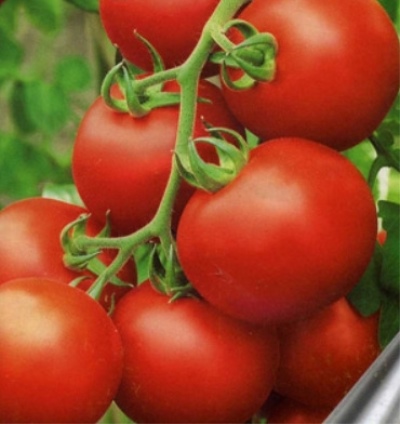
- Authors: Association for seed production of vegetable crops "Sortsemovosch", Chelyabinsk Research Institute of Selection and Seed Production of Vegetable Crops - a division of LLC "Heterosis selection"
- Year of approval: 1951
- Category: grade
- Growth type: determinant
- Appointment: universal
- Ripening period: mid-early
- Ripening time, days: 98-114
- Growing conditions: for open ground, for film greenhouses
- Marketability: high
- Bush size: undersized and medium-sized
Most regions of the Russian Federation are characterized by cool summers with high humidity. Belarusian tomato varieties are popular among gardeners. Variety Peremoga 165 is unpretentious, gives a bountiful harvest and tasty fruits.
Description of the variety
The tomato variety was bred by Belarusian breeders on the basis of the republican Institute of Fruit Growing in 1951. The Peremog 165 variety is universal and suitable for cultivation throughout Russia.
The main feature of the variety is early ripening of fruits. The variety is intended for cultivation in areas with short summers. A large number of fruits are tied on the bushes, even in low light conditions. Tomato Peremoga 165 is determinant, grows in height only up to 60 cm. The plantings are close to the ground, which provides additional heating.
Tomato bushes have a moderate foliage. Medium-sized dark green standard sheets are slightly corrugated. The simple and compact inflorescence sometimes has an intermediate type. The first is formed over 6-8, and the rest - after 2 sheets. 2-5 brushes are laid on the main stem. On each, 2-4 tomatoes are tied.
The main plus of the variety is unpretentiousness. Landings do not need special care. Tomato yields are good in any climatic conditions. Tomatoes tolerate sharp temperature changes well. In such conditions, they fully ripen and bear fruit perfectly. The most suitable soil for the variety is sandy loam. In the south, the variety can be planted in shaded areas, filling garden beds near fences or trees.
The variety is versatile, suitable for cultivation in unprotected soil and greenhouses. When growing tomatoes in regions with a harsh climate, it is recommended to use the second method. The fruits are eaten fresh or canned.
The main qualities of the fruit
The strong skin of the tomato provides resistance to transportation and long-term storage. Tomatoes have a flat-round shape with slight ribbing, and their surface is smooth. Unripe green fruits have a dark spot at the stalk. The number of nests reaches 4-9, and the location is correct and incorrect.
Ripe tomatoes are bright red. The fruits are medium-sized, but some weigh up to 150 g. Most often, the mass of tomatoes does not exceed 88-130 g.
Taste characteristics
The fruits are distinguished by good and pleasant taste. They have a rather thin but tough skin. Juicy pulp is fresh and sweetish. Peremog 165 tomatoes make a delicious juice.
Ripening and fruiting
The considered variety is medium early, the period from full germination to ripening of fruits is 97-107 days. On each brush, 2-4 tomatoes are formed. The bushes are abundantly covered with tomatoes. Sometimes the first tomatoes ripen 90 days after the seedlings are planted.
Yield
If you take good care of the plantings, you can collect up to 5 kg of fruit from each bush. With minimal care for planting, the yield does not exceed 2.5 kg. From 1 m2, the gardener will receive up to 20 kg of tomatoes. For the best yield, it is recommended to plant the tomato Peremog 165 by the seedling method.
The timing of planting seedlings and planting in the ground
The region of residence affects the timing of planting seedlings. In the southern latitudes, the procedure can be carried out from the end of April, in the middle latitudes - from the last ten days of May, and in the northern latitudes - from the beginning of June. The approximate time for planting seeds for seedlings is 50 days before planting in the ground.

Growing tomato seedlings is an extremely important process, because it largely depends on whether the gardener can harvest at all. All aspects must be taken into account, from seedbed preparation to planting in the ground.
Landing scheme
7 days before planting seedlings in the ground, it is worth adding top dressing. For hardening, put dishes with sprouts in the sun. It is recommended to take seedlings outside for 2 hours a day for 14 days.
When planting seedlings, observe a distance of 60 cm between them. Leave similar gaps between the rows. Then the plants will receive a sufficient amount of light.
Plant seedlings 40 days old in the ground. During the preparation period, fertilize the soil 2 times.

Growing and care
After planting, it is necessary to regularly moisten the soil, loosen, fertilize and remove weeds. Only warm water should be used for irrigation. It is advisable to carry it out in the evening.
After each moistening of the soil, loosen the soil. To avoid the appearance of pests, you should weed the beds. Weed plants take up the nutrients that tomatoes need for growth and maturation.




A plant needs different micronutrients at each stage of growth. All fertilizers can be divided into two groups: mineral and organic. Folk remedies are often used: iodine, yeast, bird droppings, eggshells.
It is important to observe the rate and period of feeding. This also applies to folk remedies and organic fertilizers.
Disease and pest resistance
Tomato Peremoga 165 has good disease resistance. The variety is immune to fungal infections. However, prophylactic spraying of bushes against other diseases is recommended. With proper care, plants rarely get sick.


Resistant to adverse weather conditions
The variety grows well in different climates, but it bears fruit best in favorable conditions. An important difference between the Peremog 165 hybrid is its good tolerance of humid summer and harsh climate.

























































































